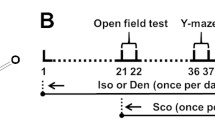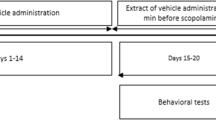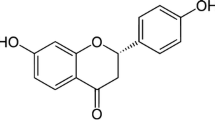Abstract
Timosaponin B-II (TB-II) is a main active saponin isolated from the rhizome of Anemarrhena asphodeloides Bge., which is widely used in traditional Chinese medicine. In this study, the effect of TB-II on learning and memory was investigated in a scopolamine-induced mouse model of Alzheimer’s disease. The results of behavioral tests indicated that TB-II significantly increased the spontaneous alternation in the Y-maze test, and reversed the shortening of step-through latency induced by scopolamine in the passive avoidance test, showing protective effects on short-term and working memory. In the Morris water maze test, TB-II reduced the escape latency time in the training trial, and increased the swimming time in the target quadrant in the probe trial. Biochemical data demonstrated that TB-II significantly inhibited acetylcholinesterase (AChE) activity in the cerebral cortex and hippocampus of mice. Moreover, TB-II markably attenuated the reduction in glutathione peroxidase (GSH-Px) and superoxide dismutase (SOD) activities, and decreased malondialdehyde (MDA) levels, which are key biomarkers of brain oxidative stress. These results indicated that TB-II offers protection against scopolamine-induced deficits in learning and memory, possibly by inhibiting AChE and preventing oxidative stress damage. The findings suggested that TB-II has a potential therapeutic effect on cognitive and behavioral impairment.




Similar content being viewed by others
References
Abbatecola AM, Olivieri F, Corsonello A, Antonicelli R, Corica F (2011) Genome-wide association studies: is there a genotype for cognitive decline in older persons with type 2 diabetes? Curr Pharm Design 4:347–356
Ahmed T, Gilani AH (2009) Inhibitory effect of curcuminoids on acetylcholinesterase activity and attenuation of scopolamine-induced amnesia may explain medicinal use of turmeric in Alzheimer’s disease. Pharmacol Biochem Be 91:554–559
Araujo AJ, Studzinski CM, Milgram NW (2005) Further evidence for the cholinergic hypothesis of aging and dementia from the canine model of aging. Prog Neuro-Psychoph 29:411–422
Banks WA (2012) Drug delivery to the brain in the Alzheimer’s disease: Consideration of the blood–brain barrier. Adv Drug Deliv Rev 64:629–639
Brandon E, Mellott T, Pizzo D, Coufal N, D’Amour K, Gobeske K, Lortie M, Lopez-Coviella I, Berse B, Thal L, Gage F, Blusztajn J (2004) Choline transporter 1 maintains cholinergic function in cholineacetyl transfer as ehaploin sufficiency. J Neurosci 24:5459–5466
Cobb CA, Cole MP (2015) Oxidative and nitrative stress in neurodegeneration. Neurobiol Dis 84:4–21
Deng XY, Chen JJ, Li HY, Ma ZQ, Ma SP, Fu Q (2015) Cardioprotective effects of timosaponin B II from Anemarrhenae asphodeloides Bge. on isoproterenol-induced myocardial infarction in rats. Chem Biol Interact 240:22–28
Droogsma E, Veeger N, vanWalderveen P, Niemarkt S, vanAsselt D (2013) Effect of treatment gaps in elderly patients with dementia treated with cholinesterase inhibitors. Proc Natl Acad Sci U S A 80:1622
Gao X, Zheng CY, Yang L, Tang XC, Zhang HY (2009) Huperzine A protects isolated rat brain mitochondria against β-amyloid peptide,. Free Radic Biol Med 46:1454–1462
Guo CR, Shen JY, Meng ZQ, Yang XL, Li F (2016) Neuroprotective effects of polygalacic acid on scopolamine-induced memory deficitsin mice, Phytomedicine 23: 149–155
Gupta VK, Chitranshi N, Gupta VB, Golzan M, Dheer Y, Wall RV, Georgevsky D, King AE, Vickers JC, Chung R, Graham S (2016) Amyloid β accumulation and inner retinal degenerative changes in Alzheimer’s disease transgenic mouse. Neurosci Lett 623:51–56
He DD, Wu H, Wei Y, Liu W, Huang F, Shi HL, Zhang BB, Wu XJ, Wang CH (2015) Effects of harmine, an acetylcholinesterase inhibitor, on spatial learning and memory of APP/PS1 transgenic mice and scopolamine-induced memory impairment mice, European Journal of Pharmacology 768: 96–107
Huang JF, Shang L, Liu P, Zhang MQ, Chen S, Chen D, Fan CL, Wang H, Xiong K (2012) Timosaponin-BII inhibits the up-regulation of BACE1 induced by Ferric Chloride in rat retina. BMC Complement Altern Med 12:1–8
Iida Y, KB O, Saito M, Matsuoka H, Kurata H, Natsume M, Abe H (1999) Detection of antifungal activity in Anemarrhenaasphodeloides by sensitive BCT method and isolation of itsactive compound. J Agric Food Chem 47:584–587
Iversen S (1997) Behavioural evaluation of cholinergic drugs. Life Sci 60:1145–1152
Jiang SH, Shang L, Xue LX, Ding W, Chen S, Ma RF, Huang JF, Xiong K (2014) The effect and underlying mechanism of Timosaponin B-II on RGC-5 necroptosis induced by hydrogen peroxide. BMC Complement Altern Med 14:1472–6882
Jollow DJ, Mitchell JR, Zampaglione N, Gillette JR (1974) Bromobenzene-induced liver necrosis. Protective role of glutathione and evidence for 3, 4-bromobenzene oxide as the hepatotoxic metabolite. Pharmacology 3:151–169
Kim DH, Hung TM, Bae KH (2007) The ameliorating effect of oroxylin A on scopolamine-induced memory impairment in mice. Neurobiol Learn Mem 87:536–546
Lan Z, Liu J, Chen LFQ, Luo J, Qu R, Kong L, Ma S (2012) Danggui-Shaoyao-San ameliorates cognition deficits and attenuates oxidative stress-related neuronal apoptosis in D-galactose-induced senescent mice. J Ethnopharmacol 141:386–395
Lee JS, Kim HG, Han JM, Kim DW, Yi MH, Son SW, Kim YA, Lee JS, Choi MK, Son CG (2014) Ethanol extract of Astragali Radix and Salviae Miltiorrhizae Radix, Myelophil, Exerts anti-amnesic effect in a mouse model of scopolamine-induced memory deficits. J Ethnopharmacol 153:782–789
Li TJ, Qiu Y, Yang PY, Rui YC, Chen WS (2007) Timosaponin B-II improves memory and learning dysfunction induced by cerebral ischemia in rats. Neurosci Lett 421:147–151
Liu J, Deng W, Fan L, Tian L, Jin L, Jin Z, Guo Q, Xu Y, Li N (2012a) The role of radix hedysari polysaccharide on thehuman umbilical vein endothelial cells induced by highglucose. Eur J Intern Med 23:287–292
Liu Y, Zhu X, Lu Q, Wang J, Li W, Wei Y, Yin X (2012b) Totalsaponins from Rhizoma Anemarrhenae amelioratediabetes-associated cognitive decline in rats: involvement ofamyloid-beta decrease in brain. J Ethnopharmacol 139:194–200
Lu W, Qiu Y, Li TJ, Tao X, Sun LN, Chen WS (2009) Timosaponin B-II inhibits proinflammatory cytokineinduction by lipopolysaccharide in BV2 cells. Arch Pharm Res 32:1301–1308
Lynch T, Cherny RA, Bush AI (2000) Oxidative processes in Alzheimer’s disease: the role of Aβ-metal interactions. Exp Gerontol 35:445–451
Ma T, Gong K, Yan YF, Zhang LH, Tang PF, Zhang XF, Gong YD (2013) Huperzine A promotes hippocampal neurogenesis in vitro and in vivo. Brain Res 1506:35–43
Moreira PI, Sayre LM, Zhu X, Nunomura A, Smith MA, Perry G (2010) Detection and localization of markers of oxidative stress by in situ methods: application in the study of Alzheimer disease. Methods Mol Biol 610:419–434
Morris R (1984) Developments of a water-maze procedure for studying spatial learning in the rat. J Neurosci Methods 11:47–60
Radomska-Leśniewska DM, Hevelke A, Skopiński P, Barbara B, Józwiak J, Rokicki D, Skopińska-Różewska E, Białoszewska A (2016) Reactive oxygen species and synthetic antioxidants as angiogenesis modulators: Clinical implications. Pharmacol Rep 68:462–471
Rijpma A, Meulenbroek O, Olde R (2014) Cholinesterase inhibitors and add-on nutritional supplements in Alzheimer’s disease: a systematic review of randomized controlled trials. Ageing Res Rev 16:105–112
Rodda J, Carter J (2012) Cholinesterase inhibitors and memantine for symptomatic treatment of dementia. BMJ 344: 537–538
Roghani M, Baluchnejadmojarad T (2009) Chronic epigallocatechin-gallate improves aortic reactivity of diabetic rats: Underlying mechanisms. Vasc Pharmacol 51:84–89
Shen Z (2004) Brain cholinesterases: II. The molecular and cellular basis of Alzheimer’s disease. Med Hypotheses 63:308–321
Shi J, Liu QF, Wang YM, Luo GA (2010) Coadministration of huperzine A and ligustrazine phosphate effectively reverses scopolamine-induced amnesia in rats. Pharmacol Biochem Be 96:449–453
Slater TF (1984) Overview of methods used for detecting lipid peroxidation. Methods Enzymol 105:283–293
Terry JA, Callahan PM, Hall B, Webster SJ (2011) Alzheimer’s disease and age-relate memory decline (preclinical). Pharmacol Biochem Be 99:190–210
Xie W, Du L (2011) Diabetes is an inflammatory disease:evidence from traditional Chinese medicines. Diabetes Obes Metab 13:289–301
Zhang HY, Tang XC (2006) Neuroprotective effects of huperzine A: new therapeutic targets for neurodegenerative disease. Trends Pharmacol Sci 27:619–625
Zhang J, Zhang M (1999) Effect of steroidal saponins of Anemarrhenae rhizoma on superoxide generation in human neutrophils. Biocheml Bioph Res Co 259:636–639
Acknowledgments
This research was supported by National Natural Science Foundation of China (No. 81573580 and No. 81403065) and Education Department of Liaoning Province (No. L2015533).
Author information
Authors and Affiliations
Corresponding author
Ethics declarations
Conflict of interest
The authors declare that there is no conflict of interests regarding the publication of this paper.
Rights and permissions
About this article
Cite this article
Zhao, X., Liu, C., Qi, Y. et al. Timosaponin B-II ameliorates scopolamine-induced cognition deficits by attenuating acetylcholinesterase activity and brain oxidative damage in mice. Metab Brain Dis 31, 1455–1461 (2016). https://doi.org/10.1007/s11011-016-9877-z
Received:
Accepted:
Published:
Issue Date:
DOI: https://doi.org/10.1007/s11011-016-9877-z




